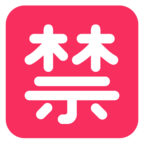🈲 Japanese 'Prohibited' Button Emoji
🈲 Emoji Information
- Name:
- Japanese 'Prohibited' Button
- Short Codes:
- :u7981:
- Keywords:
- “prohibited”, ideograph, Japanese, Japanese “prohibited” button, 禁
- Category:
- Symbols » Alphanum
- Introduced:
- 2010
- Unicode Codepoint(s):
-
🈲U+1F232
- Modifier:
- Not Available
🈲 Japanese 'Prohibited' Button Meaning
The "prohibited" button emoji in japanese. It's an extremely basic emoji, such as a stop sign. No option to proceed. No, you are not free to do whatever you please. Get away from here; it's private property. With a cigarette warning, no smoking. Don't speak. No beverages, etc. To try to convey to you what the word "forbidden" means is kind of strange. The parents are responsible for it. So, just keep in mind: if you get two stars on top, two lines horizontally in the middle, and three vertical lines at the bottom for your request, damn, you'd best think of something else to do.
The Japanese 'Prohibited' button emoji was introduced in 2010 and released as part of the Unicode 11.0 standard. This emoji can be found under the symbols category. Because the Japanese 'Prohibited' button emoji has been around for quite some time, it should display correctly in the majority of operating systems.
🈲 Emoji on Different Devices
Here you'll find a range of emojis on how they will look using different operating systems.
Each company will design an emoji according to their own style. Here we have listed the most popular platforms around to see how the emoji will look on their screens.
Depending on the operating system version, the images may still look different to your display.
- Google

- Apple

- Facebook

- Twitter

- Windows

- Samsung

🈲 Worldwide Trend
🈲 Developer Codes
- Short Codes:
- :u7981:
- Hex Code:
-
🈲 - Decimal Code:
-
🈲 - Punycode:
-
xn--k97h - URL Escape Code:
-
%F0%9F%88%B2 - JavaScript & JSON:
-
\ud83c\ude32 - CSS Code:
-
content: '\1F232';
